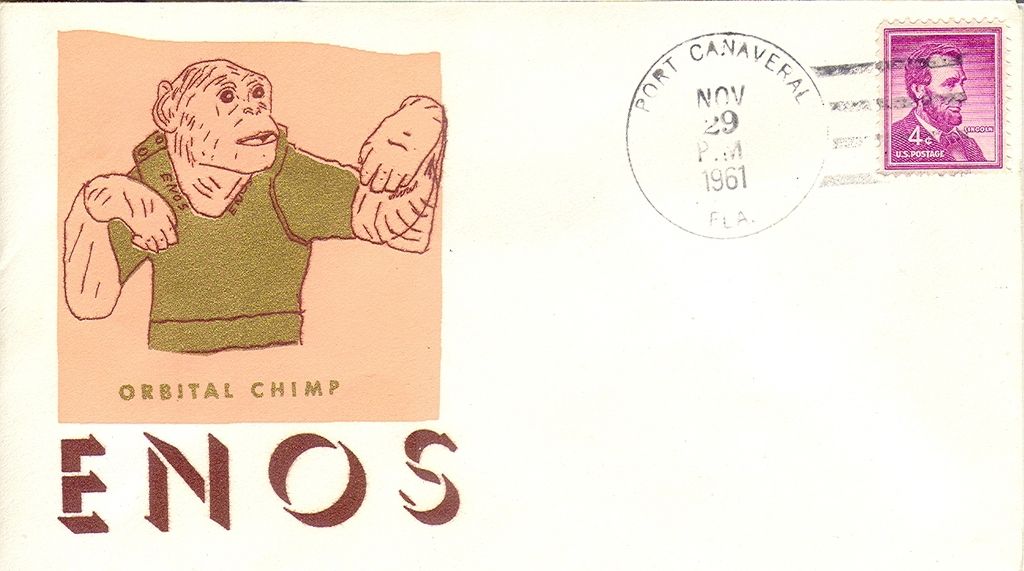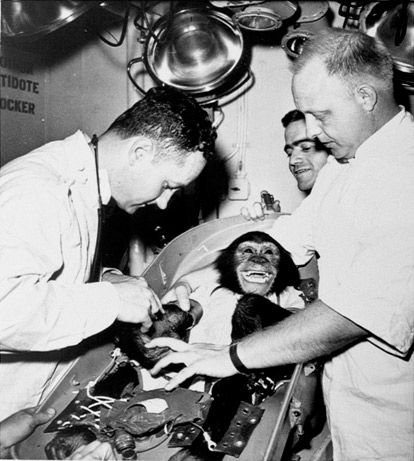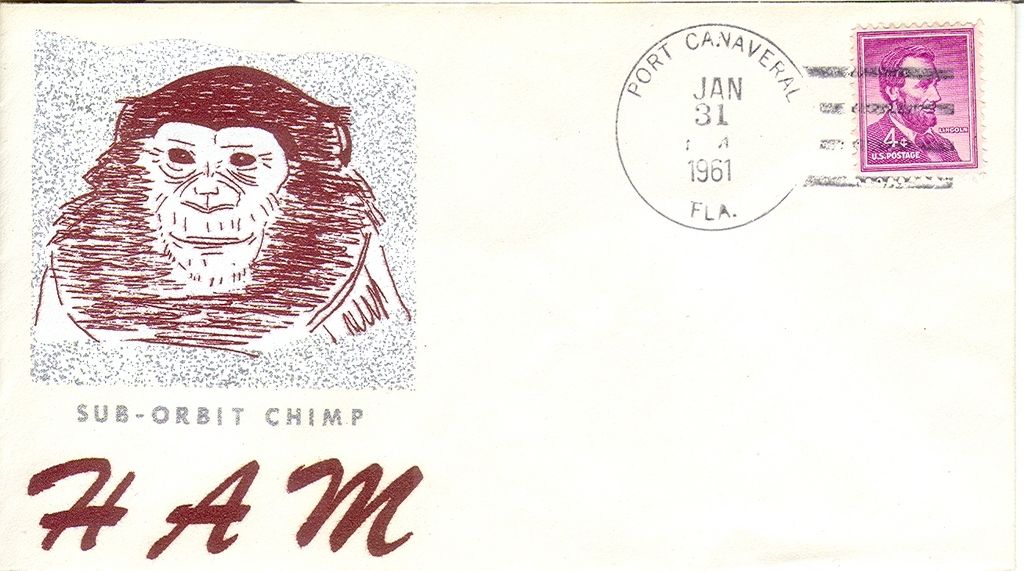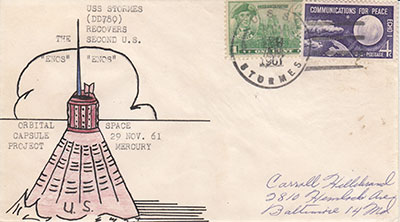The Robert Rank velvet space cover pictured is the earliest of his manned (chimp) spaceflight covers and properly belongs in space cover collections that note the contribution of space chimps to the achievement of NASA space flight missions. The cover shown is from the Rank collection of space covers of Space Unit collector and well known astrophilatelist, Jane Beville. Space chimp Ham's name is an acronym for Holloman Aerospace Medical Center, and he is one of two chimps that are outfitted the morning of the flight of the Mercury Redstone-2 spaceflight. A second chimp, a female, is also suited up, but Ham's spunkiness, attentiveness, and energy make him the selected chimp for the flight. The test flight of astro chimp Ham in Mercury Redstone-2 is a full dress rehearsal for an anticipated manned ballistic spaceflight to be made in a few weeks by Project Mercury astronaut Alan Shepard.
Ham is launched into a picture perfect blue sky over Cape Canaveral on his suborbital flight in Mercury Redstone-2, five minutes before noon on January 31, 1961. He splashes down 16.5 minutes later, 363 miles downrange, and 60 miles from the nearest recovery ship for his mission, U. S. Navy destroyer USS Ellison, DD-864. Two MAG-26 helicopters from primary recovery ship, USS Donner, LSD-20, fly to space chimp Ham's splashdown position and make a successful recovery.
Upon recovery of Ham's space capsule, the recovery team finds two holes in the titanium bulkhead of the space craft caused by impact of the splashdown of the capsule in the Atlantic Ocean, and they also find an open inlet valve. The leaks and intrusion of seawater start to sink the space capsule, but one of the MAG-26 recovery helos lifts the leaky space craft with Ham and flies him to safety and the deck of the primary recovery ship, USS Donner.
Upon landing on the ship after his flight, Ham is found to be in good condition and readily accepts the award of an apple and half an orange from his trainer. The space chimp has performed superbly in his flight into space. More importantly, Ham's successful flight proves that an astronaut also can survive a Project Mercury suborbital flight in space. Will an astronaut be able to perform as well?
Space Cover #409 – Space Monkeys Everywhere!
Another anniversary of space chimp Ham has recently passed and another space chimp Enos Fiftieth anniversary is on the horizon. Because of these two key anniversary dates, I feel it is necessary to remember that before astronaut Alan Shepard and before cosmonaut Yuri Gagarin, there was an American in space, and that astro chimp was named Ham.

The cover above for astrochimp Enos mission is a critical link in NASA's qualification of the Project Mercury spacecraft on November 29, 1961, for orbital spaceflight with Mercury astronauts.
After the space flight of Ham, January 31, 1961, the flight of space monkey Enos in Mercury Atlas-5 becomes a full-scale dress rehearsal for the approaching Project Mercury manned spaceflight of astronaut John Glenn scheduled for December 1961. The space chimpanzee's flight is a precursor to manned orbital spaceflight by an astronaut for NASA. From the French Cameroons, astrochimp Enos is described as, "...a cool guy and not the performing type at all," as evaluated by the flight's Chief Veterinarian, Jerry Fineg.
Astrochimp Enos blasts into the stratosphere in a near perfect launch from LC-14 the morning of November 29, 1961, at Cape Canaveral, Florida. Enos achieves Earth orbit 480 miles from Cape Canaveral at an altitude of 100 miles and a speed of 25,695 feet per second or 17,519 miles per hour. Supporting Enos and his Mercury Atlas-5 flight are 18 worldwide tracking stations, plus the Goddard Space Flight Center and the Mercury Control Center in this second live test of the Project Mercury tracking network.
Enos' flight was supposed to be a three-orbit flight, but his spacecraft was not maintaining proper attitude and NASA officials decide to reenter the space chimp and his spacecraft after two orbits. His flight is completed after 1 hour and 28.5 minutes. After his recovery on primary recovery ship USS Stormes, the recovery team reports the astro chimp jumps for joy upon return to Earth and splashdown in the Atlantic Ocean..
After removal from his space capsule, Enos runs around the ship's main deck enthusiastically shaking hands with his trainers and recovery team personnel. Space monkey Enos' flight is a full dress rehearsal for the forthcoming Project Mercury manned spaceflight scheduled in early February 1962 when it is anticipated that astronaut John Glenn will orbit the Earth in Mercury Atlas-6 and spacecraft Friendship 7. The success of Enos' orbital spaceflight is a major success for a manned orbital flight for Project Mercury.
Special thanks is given to Dennis Dillman for providing these two astro chimp covers from the space cover collection of Jane Beville. Robert Rank's manned spaceflight covers of the Mercury 7 astronauts are not difficult for a collector to find, however finding these two astrochimp covers for the manned chimp space missions of Ham and Enos are another story.
— Steve SU 4379
















